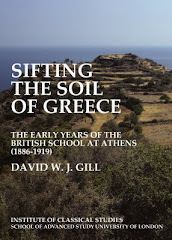 In April 1896 Robert Carr Bosanquet described to his sister Caroline the excavations at 'the Hall of the Mystae' on Melos.
In April 1896 Robert Carr Bosanquet described to his sister Caroline the excavations at 'the Hall of the Mystae' on Melos.A few days later we found a statue, headless alas, lying on its back on the mosaic pavement ...It represents a hierophant ... of Dionysos, probably, and was set up by the Mystae or Initiates. The mosaic is an unusually large one, some 40 feet in length, and 10 feet wide, and on the whole well preserved. Yesterday we finished clearing away the stone dykes and soil that overlay the upper end and were overwhelmed by the beauty of the upper compartment: it has a vine in each corner whose branches spread over the field: among them are birds of gorgeous plumage, pheasants and peacocks, at one side a deer or goat lying down. The colouring is very rich and the design good. It is probably the best mosaic that has been discovered in Greece. I am anxious to arrange for its permanent preservation and am wiring to Cecil Smith, whom I suppose to be in Athens, to that effect. He has left me in charge for over 3 weeks and I have only heard from him once, so I am anxiously awaiting his coming.The drawing was made by Charles R.R. Clark, the excavation's architect.
Bibliography
Bosanquet, R. C. 1898. "Excavations of the British School at Melos. The Hall of the Mystae." Journal of Hellenic Studies 18: 60-80, pls. i-iii.






No comments:
Post a Comment